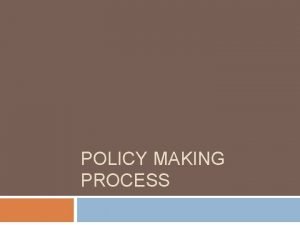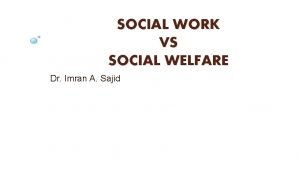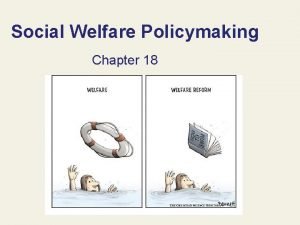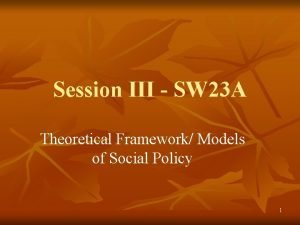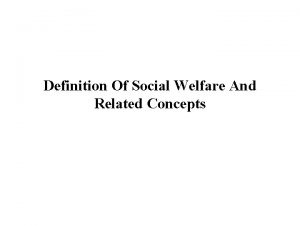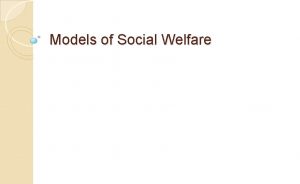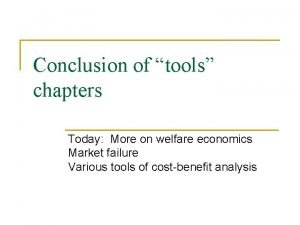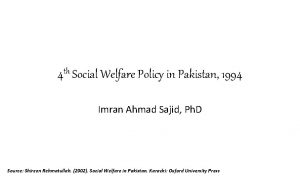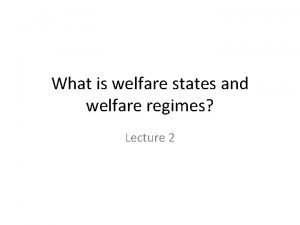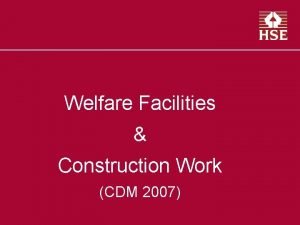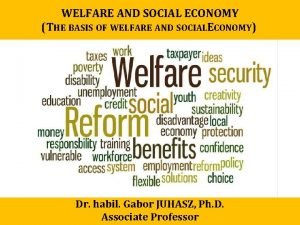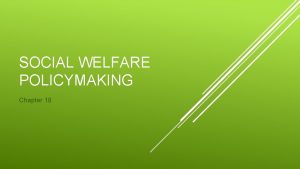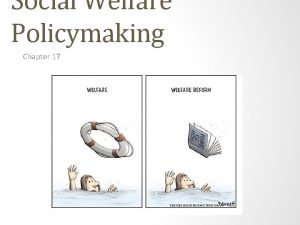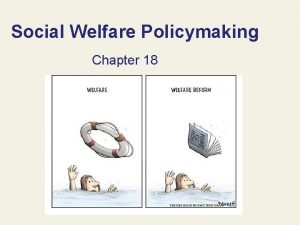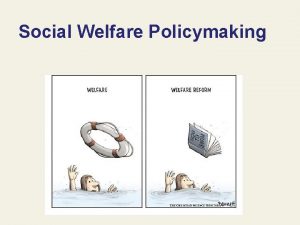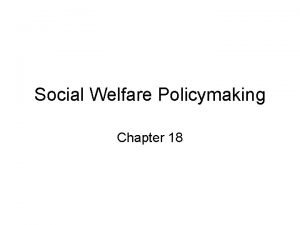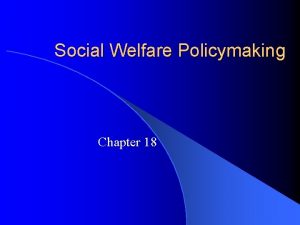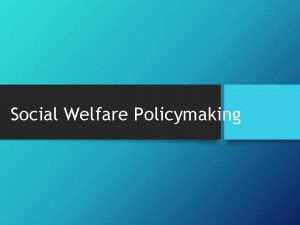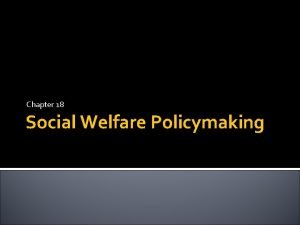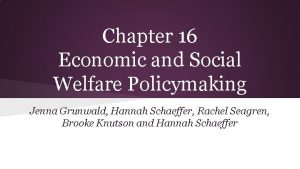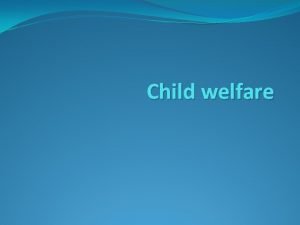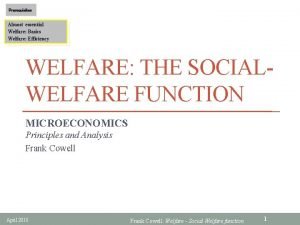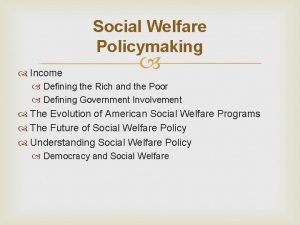Social Welfare Policymaking Chapter 18 What is Social

















- Slides: 17

Social Welfare Policymaking Chapter 18

What is Social Policy and Why is it so Controversial? l Social welfare policies provide benefits to individuals, either through entitlements or means-testing. – Entitlement programs: Government benefits that certain qualified individuals are entitled to by law, regardless of need. – Means-tested programs: Government programs only available to individuals below a poverty line.

Income, Poverty, and Public Policy l Who’s Getting What? – Income: amount of funds collected between any two points in time. – Wealth: amount of funds already owned.

Income, Poverty, and Public Policy

Income, Poverty, and Public Policy l Who’s Poor in America? – Poverty Line: considers what a family must spend for an “austere” standard of living. – In 2000 the poverty line for a family of three was $14, 129. – Many people move in and out of poverty in a year’s time. – Feminization of poverty: high rates of poverty among unmarried women

Income, Poverty, and Public Policy l Poverty Rates by Race and Hispanic Origin: 1959 -2001 (Figure 18. 1)

Income, Poverty, and Public Policy l What Part Does Government Play? – Taxation. Progressive tax: people with higher incomes pay a greater share. l Proportional tax: all people pay the same share of their income. l Regressive tax: opposite of a progressive tax l Earned Income Tax Credit: “negative income tax” that provided income to very poor people. l

Income, Poverty, and Public Policy l What Part Does Government – Government Expenditures. Play? Transfer payments: benefits given by the government directly to individuals. l Some transfer benefits are actual money. l Other transfer benefits are “in kind” benefits where recipients get a benefit without getting actual money, such as food stamps. l Some are entitlement programs, others are meanstested. l

Income, Poverty, and Public Policy

Helping the Poor? Social Policy and Poverty l “Welfare” as We Knew it – Social Security Act of 1935 was the first major step by the federal government to help protect people against absolute poverty. – The Social Security Act set up AFDC, a national assistance program for poor children. – President Johnson declared a “war on poverty” and created many new social welfare programs.

Helping the Poor? Social Policy and Poverty l “Welfare” as We Knew it (continued) – President Reagan cut welfare benefits and removed people from benefit rolls. – Conservatives argued that welfare programs discouraged the poor from solving their problems. – Attitudes toward welfare became “race coded”, the belief that most on welfare were African Americans.

Helping the Poor? Social Policy and Poverty l Ending Welfare as we Knew it: The Welfare Reforms of 1996 – Personal Responsibility and Work Opportunity Act l l Each state to receive a fixed amount of money to run its own welfare programs People on welfare would have to find work within two years. Lifetime limit of five years placed on welfare. AFDC changed to Temporary Assistance for Needy Families (TANF)

Living on Borrowed Time: Social Security l The New Deal, the Elderly, and the Growth of Social Security – Social Security has grown rapidly since 1935, adding Medicare in 1965. – Employers and employees contribute to the Social Security Trust Fund. – The Trust Fund is used to pay benefits. – But, the ratio of workers to beneficiaries is narrowing; Trust Fund will soon be in the red.

Living on Borrowed Time: Social Security l Social Security and Health Drive the Federal Budget (Figure 18. 2)

Living on Borrowed Time: Social Security l The Future of Social Security – The number of Social Security contributors (workers) is growing slowly, the number of recipients (retired) is growing rapidly. – At some time, payouts will exceed income. – Solutions of cutting benefits or raising taxes are hard choices. – Republicans favor privatizing Social Security.

Social Welfare Policy Elsewhere – Many industrialized nations are more generous than the U. S. – But the tax rates are higher in those countries than in the U. S. – Other countries (especially European) have worked to reform their welfare programs.

Understanding Social Welfare Policy l Democracy and Social Welfare – The U. S. has the smallest social welfare system. – There is considerable unequal political participation by those that use the programs.
 Policy adoption
Policy adoption Social welfare vs social work
Social welfare vs social work Examples of social welfare programs
Examples of social welfare programs What is industrial achievement-performance model
What is industrial achievement-performance model Explain the model of social group work
Explain the model of social group work What is welfare
What is welfare Social welfare models
Social welfare models Conclusion of welfare economics
Conclusion of welfare economics 2nd social welfare policy in pakistan
2nd social welfare policy in pakistan Economic ethics
Economic ethics Social welfare in colombia
Social welfare in colombia Ethics and social welfare
Ethics and social welfare Apa itu social thinking
Apa itu social thinking Social thinking social influence social relations
Social thinking social influence social relations What is welfare
What is welfare What is welfare
What is welfare Cdm welfare facilities
Cdm welfare facilities What is welfare
What is welfare
